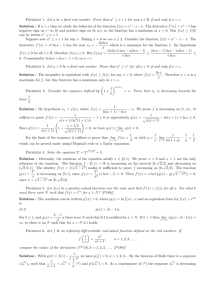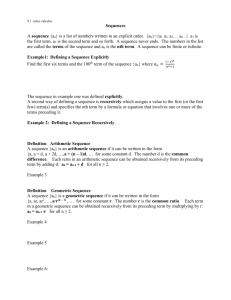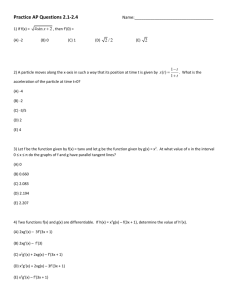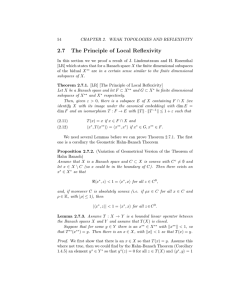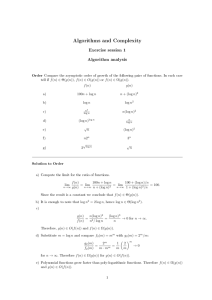The Prime Number Theorem and the Series ∑ µ(n) n
advertisement
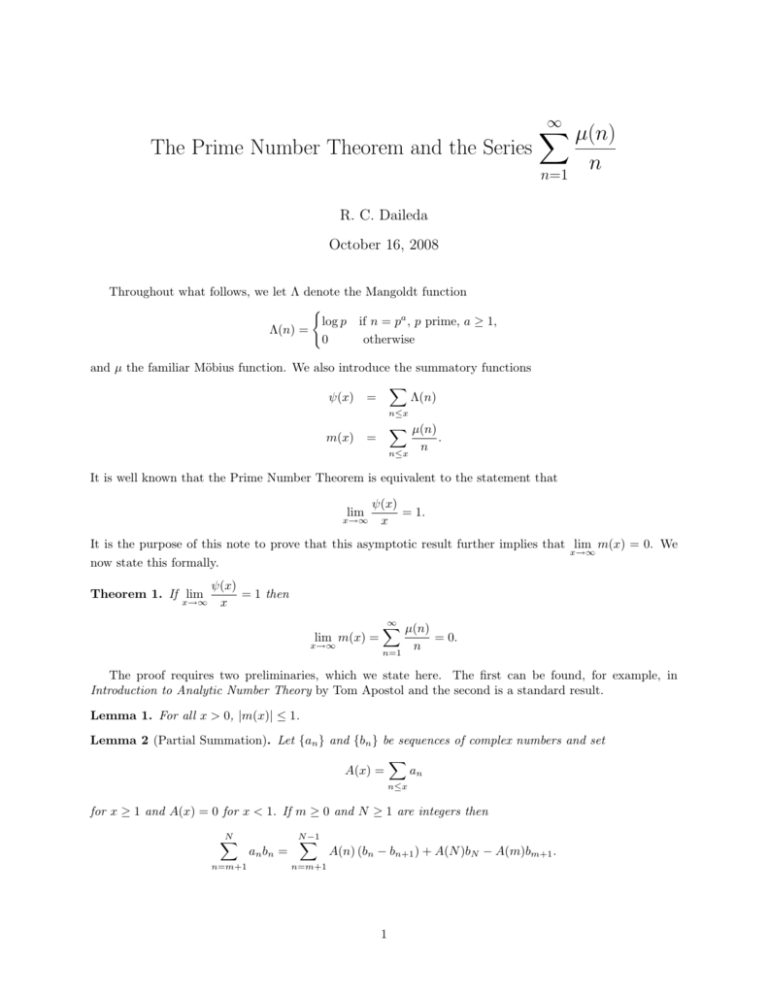
The Prime Number Theorem and the Series
∞
X
µ(n)
n=1
n
R. C. Daileda
October 16, 2008
Throughout what follows, we let Λ denote the Mangoldt function
(
log p if n = pa , p prime, a ≥ 1,
Λ(n) =
0
otherwise
and µ the familiar Möbius function. We also introduce the summatory functions
X
ψ(x) =
Λ(n)
n≤x
m(x)
X µ(n)
.
n
=
n≤x
It is well known that the Prime Number Theorem is equivalent to the statement that
lim
x→∞
ψ(x)
= 1.
x
It is the purpose of this note to prove that this asymptotic result further implies that lim m(x) = 0. We
x→∞
now state this formally.
Theorem 1. If lim
x→∞
ψ(x)
= 1 then
x
lim m(x) =
x→∞
∞
X
µ(n)
= 0.
n
n=1
The proof requires two preliminaries, which we state here. The first can be found, for example, in
Introduction to Analytic Number Theory by Tom Apostol and the second is a standard result.
Lemma 1. For all x > 0, |m(x)| ≤ 1.
Lemma 2 (Partial Summation). Let {an } and {bn } be sequences of complex numbers and set
X
A(x) =
an
n≤x
for x ≥ 1 and A(x) = 0 for x < 1. If m ≥ 0 and N ≥ 1 are integers then
N
X
n=m+1
an bn =
N
−1
X
A(n) (bn − bn+1 ) + A(N )bN − A(m)bm+1 .
n=m+1
1
Taking m = 0 in the lemma and manipulating the resulting expression yields
N
X
an bn =
n=1
N
X
A(n) (bn − bn+1 ) + A(N )bN +1 .
(1)
n=1
It is in this form that we will need the lemma later.
Proof of Theorem 1. We begin by observing that if I(n) = [1/n] and u(n) = 1 for all n then the convolution
identity I = µ ∗ u implies
I(n) X µ(d)
I(n) =
=
n
n
d|n
so that
1
X X µ(d)
=
n≤x d|n
n
X µ(d) X 1
d
k
d≤x
k≤x/d
X µ(d)
x
d
=
log + γ + O
d
d
x
=
d≤x
X µ(d) log d
+ O(1)
d
= m(x) log x −
d≤x
where γ is Euler’s constant and we have appealed to Lemma 1 to produce the error term. Thus
1 X µ(d) log d
1
m(x) =
+O
log x
d
log x
d≤x
and to establish the theorem it is therefore sufficient to prove that
1 X µ(d) log d
= 0.
x→∞ log x
d
lim
(2)
d≤x
At this point let’s pause for some motivation for what comes next. In order to prove (2) we would like to
express the arithmetic function µ log as a convolution and apply the usual interchange of order of summation
trick. There are certainly many ways to do this, but we seek an identity that relates to our hypothesis about
ψ. What we have assumed is that
ψ(x)
1X
− 1 = lim
(Λ(n) − 1) ,
x→∞ x
x→∞ x
0 = lim
n≤x
i.e. that we have an asymptotic formula for the average of Λ − u. This suggests that we try to express µ log
in terms of Λ − u. This is quite easy, for from the identity Λ = −u ∗ µ log we have
µ log
= −µ ∗ Λ
=
−µ ∗ Λ + I − I
=
−µ ∗ Λ + µ ∗ u − I
= µ ∗ (u − Λ) − I.
2
We therefore have
X µ(n) log n
n
X X (1 − Λ(d)) µ
=
n
n≤x d|n
n≤x
n
d
−1
1 X µ(k)
−1
d
k
d≤x
k≤x/d
X
1 x
=
(1 − Λ(d)) m
− 1.
d
d
X
=
(1 − Λ(d))
(3)
d≤x
If we take N = [x], an = 1 − Λ(n) and bn =
N
X
(d − ψ(d))
d=1
1 x
then by (1) the expression (3) is equal to
m
n
n
1 x
1
−
m
m
d
d
d+1
x
d+1
1
+ (N − ψ(N ))
m
N +1
x
N +1
− 1.
(4)
Since
x 1
1 x
1
x
x
x
1
m
−
m
= −m
m
m
+
d
d
d+1
d+1 d+1
d
d+1
d(d + 1)
d X
1
1
1
≤
+ ,
d
m d2
x/(d+1)<m≤x/d
where again we have appealed to Lemma 1, we find that the absolute value of (4) is bounded by
N X
1 − ψ(d) d d=1
X
x/(d+1)<m≤x/d
N X
1
ψ(N ) ψ(d) 1 +
1 − d d + 1 − N + 1
m
d=1
and hence this provides an upper bound for the sum
X µ(n) log n
. Recalling our hypothesis and our goal,
n
n≤x
we find now that it suffices to prove that
N 1 X ψ(d) lim
1 − d x→∞ log x
d=1
X
x/(d+1)<m≤x/d
N 1
1 X ψ(d) 1
= lim
1 − d d = 0.
m x→∞ log x
(5)
d=1
ψ(x)
ψ(x) Let > 0. Since lim
= 1 there is a constant C so that 1 −
≤ C for all x and a y > 0 so
x→∞ x
x ψ(x) that 1 −
≤ for all x ≥ y. Thus if x > y + 1
x N X
1 − ψ(d) d d=1
X
x/(d+1)<m≤x/d
1
m
≤ C
X
X
d≤y x/(d+1)<m≤x/d
X
≤ C
x/(y+1)<m≤x
Since
X
1
+
m
X
d≤x x/(d+1)<m≤x/d
X 1
1
+
.
m
m
1
m
(6)
m≤x
X 1
= log z + γ + O(1/z) (in which the implied constant can be taken to be 2) for all z > 0 we have
m
m≤z
X
x/(y+1)<m≤x
1
= log(y + 1) + O(1) ≤ 2 log(y + 1)
m
3
as long as y is large enough (which we can have arranged earlier) so that (6) is less than or equal to
2C log(y + 1) + 2 log x.
Dividing by log x we thus have
N 1 X ψ(d) 1 − d log x
d=1
X
x/(d+1)<m≤x/d
for all x > y + 1. If we now choose x0 > y so that
2C log(y + 1)
< for all x ≥ x0 then we find that
log x
N ψ(d) 1 X 1
−
log x
d d=1
1
2C log(y + 1)
≤
+ 2.
m
log x
X
x/(d+1)<m≤x/d
1
< 3
m
for x ≥ x0 . Since > 0 was arbitrary, this proves the first limit of (5) is 0. That the second is also zero is
proven in an entirely analogous fashion and is left to the reader. As noted above, this completes the proof
of the theorem.
4






